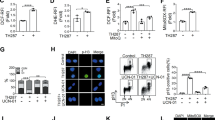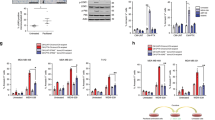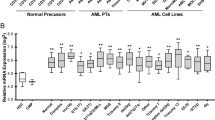Abstract
Arsenic trioxide (As2O3), an effective drug for the treatment of acute promyelocytic leukemia (APL), can induce apoptosis and partial differentiation in APL cells in vitro and in vivo. However, As2O3 also induces apoptosis in cancer cells other than APL with complex mechanisms, which seem to be cell type dependent. In this study, we report that APL cells (NB4 cell line) are arrested at early mitotic phase before the collapse of mitochondrial transmembrane potential (Δϕm) and apoptosis after treatment with pharmacological concentrations (1.0–2.0 μ M) of As2O3. We have also made the following new discoveries: (1) 0.5 μ M As2O3 that fails to induce apoptosis has no effects on cell cycle distribution. (2) With inhibition of As2O3-induced Δϕm collapse and apoptosis, dithiothreitol also effectively inhibits As2O3-induced mitotic arrest, suggesting that both As2O3-induced apoptosis and mitotic arrest involve proteins with thiol groups. (3) 1.5 mM caffeine that relieves cells from G2/M arrest also inhibits As2O3-induced Δϕm collapse and apoptosis, (4) 1.0 μ M As2O3 increases the expression of both cyclin B1 and hCDC20 whereas it inhibits Tyr15 phosphorylation of p34cdc2. In conclusion, our results strongly support that there is a tight link between As2O3-induced apoptosis and mitotic arrest, the latter being one of common mechanisms for As2O3-induced apoptosis in cancer cells.
This is a preview of subscription content, access via your institution
Access options
Subscribe to this journal
Receive 12 print issues and online access
$259.00 per year
only $21.58 per issue
Buy this article
- Purchase on Springer Link
- Instant access to full article PDF
Prices may be subject to local taxes which are calculated during checkout





Similar content being viewed by others
References
de The H, Lavau C, Marchio A, Chomienne C, Degos L, Dejean A . The PML-RAR alpha fusion mRNA generated by the t(15;17) translocation in acute promyelocytic leukemia encodes a functionally altered RAR. Cell 1991; 66: 675–684.
Melnick A, Licht JD . Deconstructing a disease: RARalpha, its fusion partners, and their roles in the pathogenesis of acute promyelocytic leukemia. Blood 1999; 93: 3167–3215.
Grisolano JL, Wesselschmidt RL, Pelicci PG, Ley TJ . Altered myeloid development and acute leukemia in transgenic mice expressing PML-RAR alpha under control of cathepsin G regulatory sequences. Blood 1997; 89: 376–387.
Kogan SC, Brown DE, Shultz DB, Truong BT, Lallemand-Breitenbach V, Guillemin MC et al. BCL-2 cooperates with promyelocytic leukemia retinoic acid receptor alpha chimeric protein (PML-RARalpha) to block neutrophil differentiation and initiate acute leukemia. J Exp Med 2001; 193: 531–543.
Huang ME, Ye YC, Chen SR, Chai JR, Lu JX, Zhoa L, Gu LJ, Wang ZY . Use of all-trans retinoic acid in the treatment of acute promyelocytic leukemia. Blood 1988; 72: 567–572.
Tallman MS, Nabhan C, Feusner JH, Rowe JM . Acute promyelocytic leukemia: evolving therapeutic strategies. Blood 2002; 9: 759–767.
Lo Coco F, Nervi C, Avvisati G, Mandelli F . Acute promyelocytic leukemia: a curable disease. Leukemia 1998; 12: 1866–1880.
Shen ZX, Chen GQ, Ni JH, Li XS, Xiong SM, Qiu QY, et al. Use of arsenic trioxide (As2O3) in the treatment of acute promyelocytic leukemia (APL): II clinical efficacy and pharmacokinetics in relapsed patients. Blood 1997; 89: 3354–3360.
Soignet SL, Maslak P, Wang ZG, Jhanwar S, Calleja E, Dardashti LJ et al. Complete remission after treatment of acute promyelocytic leukemia with arsenic trioxide. N Engl J Med 1998; 339: 1341–1348.
Zhang TD, Chen GQ, Wang ZG, Wang ZY, Chen SJ, Chen Z . Arsenic trioxide, a therapeutic agent for APL. Oncogene 2001; 20: 7146–7153.
Chen GQ, Shi XG, Tang W, Xiong SM, Zhu J, Cai X et al. Use of As2O3 in the treatment of acute promyelocytic leukemia (APL): I. As2O3 exerts dose-dependent dual effects on APL cells. Blood 1997; 89: 3345–3353.
Zhu XH, Shen YL, Jing YK, Cai X, Jia PM, Huang Y et al. Apoptosis and growth inhibition in malignant lymphocytes after treatment with arsenic trioxide at clinically achievable concentrations. J Natl Cancer Inst 1999; 91: 772–778.
Rousselot P, Labaume S, Marolleau JP, Larghero J, Noguera MH, Brouet JC et al. Arsenic trioxide and melarsoprol induce apoptosis in plasma cell lines and in plasma cells from myeloma patients. Cancer Res 1999; 59: 1041–1048.
Siu KP, Chan JY, Fung KP . Effect of arsenic trioxide on human hepatocellular carcinoma HepG2 cells: inhibition of proliferation and induction of apoptosis. Life Sci 2002; 71: 275–285.
Cai X, Shen YL, Zhu Q, Jia PM, Yu Y, Zhou L et al. Arsenic trioxide-induced apoptosis and differentiation are associated respectively with mitochondrial transmembrane potential collapse and retinoic acid signaling pathways in acute promyelocytic leukemia. Leukemia 2000; 14: 262–270.
Larochette N, Decaudin D, Jacotot E, Brenner C, Marzo I, Susin SA et al. Arsenite induces apoptosis via a direct effect on the mitochondrial permeability transition pore. Exp Cell Res 1999; 249: 413–421.
Huang C, Li J, Ding M, Wang L, Shi X, Castranova V et al. Arsenic-induced NFkappaB transactivation through Erks- and JNKs-dependent pathways in mouse epidermal JB6 cells. Mol Cell Biochem 2001; 222: 29–34.
Jiang XH, Wong BC, Yuen ST, Jiang SH, Cho CH, Lai KC et al. Arsenic trioxide induces apoptosis in human gastric cancer cells through up-regulation of p53 and activation of caspase-3. Int J Cancer 2001; 91: 173–179.
Park JW, Choi YJ, Jang MA, Baek SH, Lim JH, Passaniti T . Arsenic trioxide induces G2/M growth arrest and apoptosis after caspase-3 activation and bcl-2 phosphorylation in promonocytic U937 cells. Biochem Biophys Res Commun 2001; 286: 726–734.
Ling YH, Jiang JD, Holland JF, Perez-Soler R . Arsenic trioxide produces polymerization of microtubules and mitotic arrest before apoptosis in human tumor cell lines. Mol Pharmacol 2002; 62: 529–538.
Gong J, Traganos F, Darzynkiewicz Z . Discrimination of G2 and mitotic cells by flow cytometry based on different expression of cyclins A and B1. Exp Cell Res 1995; 20: 226–231.
Kumagai A, Guo Z, Emami KH, Wang SX, Dunphy WG . The Xenopus chk1 protein kinase mediates caffeine-sensitive pathway of checkpoint control in cell-free extracts. J Cell Biol 1998; 42:1559–1569.
Hoyt MA . A new view of the spindle checkpoint. J Cell Biol 2001; 154: 909–911.
Sudakin V, Chan GK, Yen TJ . Checkpoint inhibition of the APC/C in HeLA cells is mediated by a complex of BUBR1, BUB3, CDC20, and MAD2. J Cell Biol 2001; 154: 925–936.
Morgan DO . Principal of CDK regulation. Nature 1995; 374: 131–134.
Takizawa CG, Morgan DO . Control of mitosis by changes in the subcellular location of cyclin-B1-Cdk1 and Cdc25C. Curr Opin Cell Biol 2000; 12: 658–665.
Acknowledgements
This work was supported in part by National Key Program (973) for Basic Research (No. 2002CB512805), National Natural Science Foundation of China (No. 30100247), Key Development Project of Science and Technology Committee of Shanghai (CGQ), 100-talent program of Chinese Academy of Sciences (CGQ) and Ho Ying-Dong Education Foundation (CGQ).
Author information
Authors and Affiliations
Rights and permissions
About this article
Cite this article
Cai, X., Yu, Y., Huang, Y. et al. Arsenic trioxide-induced mitotic arrest and apoptosis in acute promyelocytic leukemia cells. Leukemia 17, 1333–1337 (2003). https://doi.org/10.1038/sj.leu.2402983
Published:
Issue Date:
DOI: https://doi.org/10.1038/sj.leu.2402983
Keywords
This article is cited by
-
The effect of aflibercept and arsenic trioxide on the proliferation, migration and apoptosis of oral squamous cell carcinoma in vitro
Molecular Biology Reports (2021)
-
PTEN is a negative regulator of mitotic checkpoint complex during the cell cycle
Experimental Hematology & Oncology (2017)
-
Arsenic trioxide induces oxidative stress, DNA damage, and mitochondrial pathway of apoptosis in human leukemia (HL-60) cells
Journal of Experimental & Clinical Cancer Research (2014)
-
HSP70 colocalizes with PLK1 at the centrosome and disturbs spindle dynamics in cells arrested in mitosis by arsenic trioxide
Archives of Toxicology (2014)
-
Azidothymidine hinders arsenic trioxide-induced apoptosis in acute promyelocytic leukemia cells by induction of p21 and attenuation of G2/M arrest
Annals of Hematology (2013)



